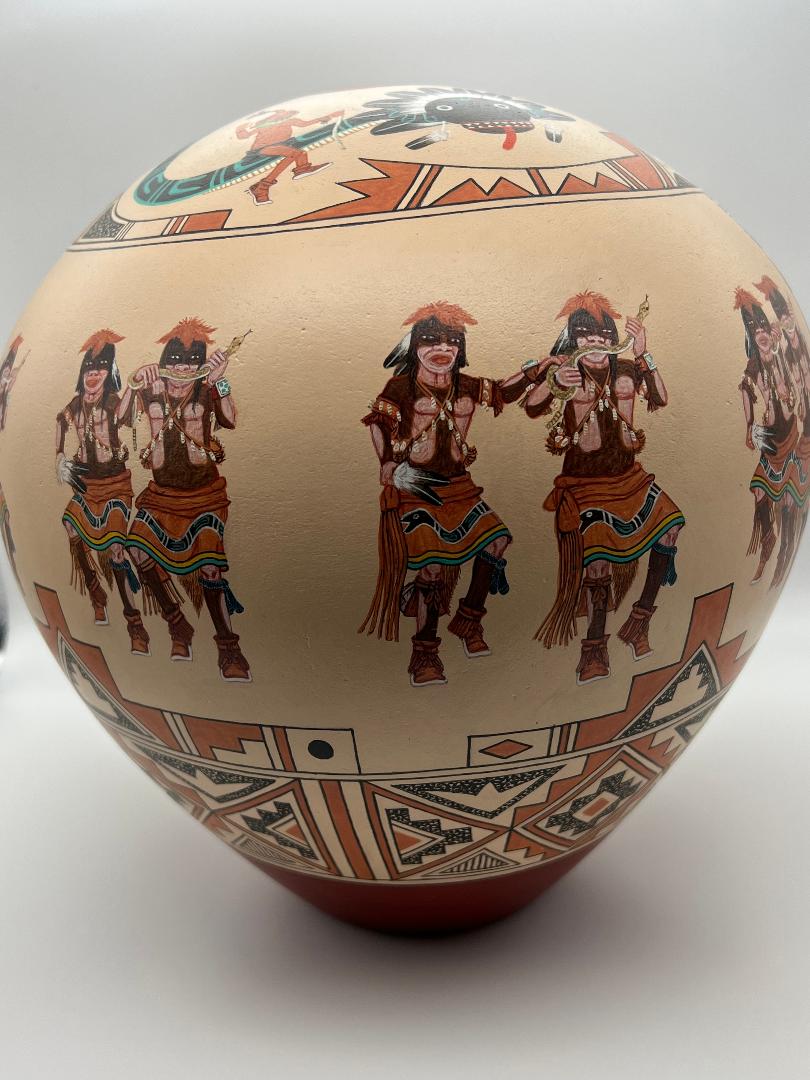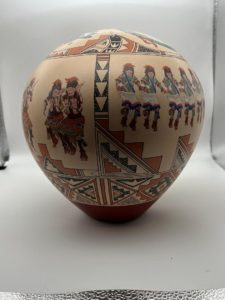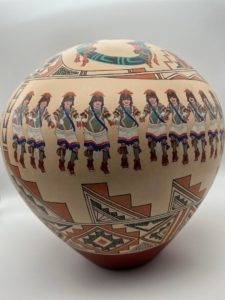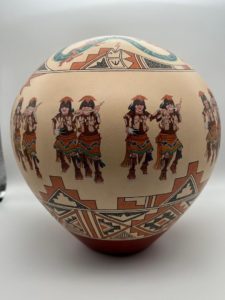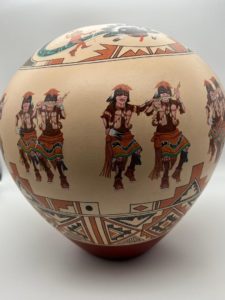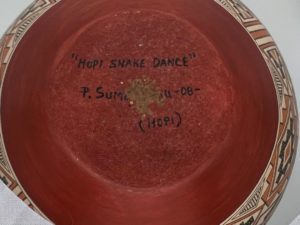This is a painted pot, but it is more accurately described as a complex mural painted on a pot. Two central rituals of Hopi religious life are depicted:
- On the flank of the jar dancers celebrate the bi-annual Snake Dance,
- On the upper surface of the jar the water serpent Pa’lulukonti emerges into this Fourth World carrying mudheads on his back.
The artist, Peter Sumatzkuku, lives in Albuquerque and is represented by Wright’s Indian Art Gallery in that city.
They describe him as painting on paper:
“With effortless skill, this self-taught Hopi artist portrays kachinas in watercolor and pen and ink. Master of the miniature, this talented artist has created amazing detail, movement and depth in…watercolor. He brings astonishing detail to miniature paintings full of color and motion.”
In contrast to this jar, most of his drawings on paper are single figures or small groups of figures. At least ten years ago Mudhead Gallery of Denver bought a group of his pottery, the original source of this seedjar. I have seen one similar jar by Sumatzkuku for sale at auction and that jar depicted some of the iconography also seen on 2020-04 and was dated “1993,” so tentatively that is the date I would assign this jar.
Form:
The seedjar expands upward and outward off a 3-inch base to about two-thirds of its height, then turns inward rising to a tiny 0.5-inch mouth. Although it is only fractionally taller than its width, the egg-like form does not appear boxy because it expands off such a small base.
It’s a large pot, but its weight of 4 pounds is surprisingly heavy for its size. I can only see the thickness of the walls at the mouth, but they appear substantial. Except for the few pots Peter sold to Mudhead Gallery, I do not know of any pottery made by him. Closing off a seedjar with such a small opening is very difficult. Perhaps Peter made this jar, but it may have been made by a more-experienced potter or be greenware (slip-cast in mold). I just don’t know. “Thunking” the jar with a finger produced a somewhat high pitch, but this is muted since there is little rim to vibrate. With this meager data to guide me, I’m guessing the jar was slip-cast and kiln fired.
Decoration:
The decoration was painted on after firing. It contains a multitude of geometric and anthropomorphic elements that are presented in a balanced and ordered manner and are best understood visually. Rendering these images into words is a complicated and detailed task, but will be undertaken here to fully understand patterns of design elements.
Three sets of framing lines encircle the jar, their placement measured in surface distance (rather that vertical distance): one is 3.5-inches below the mouth, a second is 3.5-inches above the base, and a third 1.75-inches above the base.
A 1.75-inch-diameter red circle surrounds the small mouth of the jar. Below the lowest framing line the sides and base of the jar also are painted red using the same paint. The entire surface of the jar between these red sections is painted with a cream-colored background, making the jar look like an oversized ostrich egg on a stand.
The bottom band of design:
Between the two lower framing lines are painted four panels displaying the same design layout. All elements in this band are outlined with thin black lines. The four panels are separated by an unpainted rectangular space marked by four parallel lines, a three-lane “highway.” The center lane is painted orange.
At the center of each panel is a design with a small orange diamond at its center, surrounded by an unpainted space of the same shape. Surrounding this space is a black square with rectangles emerging from each side, resulting in diamond form, each side having one step. The black in this design is speckled white. Surrounding this design is a thin smooth orange diamond with the same orientation. It, in turn, is surrounded by another stepped diamond, also orange, with the same form as the black diamond at its center.
The orange strips that are the outer edge of the “highways” that separate the four panels of design are also one side of an equilateral triangle that points to the center of the panel, its tip touching the central orange diamond. This placement has the effect of dividing the left and right areas of each design panel into three sections: 1) above the orange triangle, 2) inside to the orange triangle, and 3) below it.
In the area above the triangle is a black isosceles triangle, speckled with white dots. The center of this form is an unpainted area is the shape either a triangular stealth bomber with a tail or a flower. (Pick one.) Inside the orange triangle are a nested series of additional triangular forms: a small solid orange form, bordered by a wide white band with a thin line at its center, all surrounded by a black stepped pyramid, again speckled with white dots. Except for that thin line, the design internal to the orange triangle is that same as half of the design at the center of the panel. Finally, below the orange triangle is another triangular element formed by thin black lines a fraction of an inch apart. The internal to this triangle are 8 to 11 vertical lines, the number varying among the eight rendition encircling the jar.
The step-edged diamond design seen repetitively throughout this panel is generally the central feature in Two Grey Hills Navajo rugs.
The central band of design:
This is the visually dominant band of design on the jar, is 5-inches in height and –if unrolled from the jar– 29-inches in length. Along the bottom edge of this space are a series of discrete geometric shapes. Above them twenty-three men perform the snake-dance. It would have been easy to depict the dancers as a single continuous line, but the artist has chosen to indicate the beginning and end of the line of dancers by drawing a vertical strip of design that bridges between the bottom and top framing lines, thus segregating one set of dancers from the next.
Vertical terminus:
The base of this vertical terminus is composes of elements familiar to us from the bottom band of design, but here drawn to a larger scale. Structured around a series of three concentric triangles defined by thin black lines, the center is a solid orange triangle, its hypothenuse a series of three steps. The hypothenuse of the surrounding triangle is constructed of three parallel lines, a two-lane “highway.” Set against the outer edge of this slope, but contained within the surrounding triangle, is a row of four black triangles forming a saw-toothed edge and painted with the familiar white-spotted black paint.
The hypothenuse of the outer triangle has four parallel lines, forming a three-lane highway, the center lane painted orange. Finally, the outer edge of this hypothenuse supports a series of four orange triangles of increasing size, the lower being the largest. Notice that the overall design of this form from the center to the outer edge has three such sawtooth patterns of increasing size and alternating orange, black, orange.
The geometric design thus far described is about 2.5-inches high, half the with of the central band of design. The remaining vertical space is filled with a simple line of four unpainted (white) downward-pointing isosceles triangles embedded in a white-speckled black background, this chain bordered on top and bottom by a short strip of parallel lines forming “highways.” The top highway has four lanes alternating unpained white and orange. The bottom highway is three lanes with the center lane painted orange.
Other geometric designs along the lower edge of the middle band of design:
Let’s return to the triangular base of the vertical terminus. To its left, this basic form of embedded triangles is repeated three additional times, with two variations. What changes is the core element. The first two renditions are built around an unpainted triangle with three black lines radiating out from the lower left point of the triangle to form a fan of smaller triangles. Moving outward we find the same configuration of elements found in the terminus design. Like the terminus rendition, the final example has a core element of a triangle but here painted black with white spots and displaying a stepped hypothenuse. Note that the design forming the base of the terminus is the largest example, with each of the three subsequent examples being smaller than the neighbor to its left.
The next element to the right is a variation of a design we saw internal to the orange triangle in the bottom band of design: three embedded triangles with both the inner and outer triangles having stepped sides. The center triangle is unpainted with two steps in its notched sides. An equilateral triangle surrounds it, its boundary defined by two parallel black lines a fraction apart, its remaining surface painted black with the familiar white dots. Set along its outer flanks is a large orange triangle, each side sculpted into two steps.
Continuing right, this design is repeated twice with the added complication of panels of elements extending off of both sides from the lower orange step of the outer triangle. In the first example, abutting the left orange step is a three-lane “highway,” ints middle-lane orange and the flanking lanes unpainted (white). Following is a rectangle diagonally divided by steps so that the bottom orange form has two-steps and the top is shaped like a sidewise “L” as it fits its orange sibling below. Growing out of the right edge of the central design is a similar, but slightly different panel, beginning with an unpainted two-lane “highway.” Next is the same rectangle diagonally divided by steps, but the format has been flipped so that the orange section is on top. This wing of design is made longer that the first by the addition of a two-lane highway, its right lane orange, followed by a black-edged unpainted (white) square with a large black dot at its center.
The last rendition of this design has the same embedded triangular form with, again, two panels of design flanking it. These panels are not a high as its neighboring rendition. Next to the left orange step of the central design is a three-lane “highway,” the center lane orange and the flanking lanes unpainted (white). Next is a familiar rectangular space, but this is left unpainted (white) with an orange diamond at its center. Off the right orange step of the central design is a four-lane highway with the seconf lane painted orange and the three others left unpainted (white). To its right is an unpainted rectangle edged with a thin black line, its right edge the base of an unpainted triangle that intrudes into the rectangular shape. Looked at slightly differently, this rectangle looks as if a “V” section has been cut away so that two residual tails touch the black line that forms the outer triangle of the base of the vertical terminus.
Dancers #1:
Almost all of the remainder of this middle band of design, above the geometric frieze, is filled with two chorus lines of dancers. As before, our description starts just to the right of the vertical terminus line and proceeds counterclockwise.
A line of of 11 blue-shirted dancers faces the viewer, each about 2.75-inches tall. They have identical costumes and are drawn with extraordinary detail. Brown top-knot feathers surmount bangs of long black hair. White eyes with black pupils are surrounded by raccoon-inspired black masks. Except for these black masks, the remained of the upper face is painted brown. White paint surrounds the mouths and flows over the lower portion of the nose to the chin. All of this detail is contained in heads about 0.75-inches tall, an extraordinary feat of miniature painting.
Grey-blue shirts cover the upper-torsos, the color interrupted by flecks of orange. Two chevrons of yellow zig-zag down the front of the shirts. Bandoliers of blue with faint white lines hang across the chest from right shoulders. These are strings of olive shells that strike each other as the dancers move and make auditory the movement of the dance. Fringed orange armbands with white shells grace biceps. White mushroom-shaped gourd rattles are held in each bent arm. The dancers are dressed in kilts, but these are not the typical embroidered kilts but rather are plain white with a lower border of orange-over-blue stripes. As is traditional, the kilts are belted with a white braided wedding sash, its fringe visible between the legs of the dancers. Grey-blue leg covering with white chevrons reflect the shirts above.The top of these covering are tied with a tan leather cord (on the dancer’s right leg) and a blue cord with some sort of hanging object (rattle?) on the left leg. Tan leather moccasins with white soles and protect the feet.
As noted above, the dancers in this line are only about 2.75-inches tall, yet the detail is so precise that at first look they appear to be decals. However, when observed with a magnifying glass a few subtle differences between the figures are discernible. For example, there are slight variations in the brown tie around the right calf. The numbers and orientation of the wedding sash fringes are slightly different from one dancer to the next.
Dancers #2:
To the right of the first lines of dancers (viewer’s perspective) is a second line of 12 snake dancers in six pairs. The heads of these dancers are identical to those of the first line of dancers:
Brown top-knot feathers surmount bangs of long black hair. White eyes with black pupils are surrounded by raccoon-inspired black masks. Except for these black masks, the remained of the upper face is painted brown. White paint surrounds the mouths and flows over the lower portion of the nose to the chin.
The dancers wear what at first seems like simple short-sleeved brown t-shirts. However, on second look, it is seen that on either side of the torsos two strips of material from the pictorial muscles to the abdomen have been cut away, leaving only a thin vertical strip connecting the collar and hem of the shirts and revealing the torsos of the dancers. Orange kilts are tied with braided wedding sashes colored a totally non-traditional orange. On the face of the kilt are undulating blue snakes. Only on the kilts of the right-most pair are the mouths visable. The body of he snakes are segmented, the segments bordered by sets of 5 vertical stripes. The central and flanking stripes of this element are black, the two remaining white. Tiny, tiny black lunettes (“gumdrops”) with two whiskers are set against the outer black stripes.
Plain brown leg covering encase the lower legs, except that here — as with the shirts above–portions on some legs have been cut away to reveal skin beneath. As with the first line of dancers:
The top of these covering are tied with a tan leather cord (on the dancer’s right leg) and a blue cord with some sort of hanging object (rattle?) on the left leg. Tan leather moccasins with white soles and protect the feet.
The left dancer carries a two-feather baho (or “paho“) prayer stick (Patterson, 1994-203) in his right hand. His left hand rests on the shoulder of his dance partner. That dancer grasps a snake with both hands, its tail coiled around his right arm and its head held in the left hand. The midsection of the snake is held firmly in the mouth of the dancer. As with the first line of dancers, the detail of painting is extraordinary and, except for slight variations, seems as if the dancers might be decals reduced in size.
Note again the framing lines placed 3.5-inches below the jar’s mouth. These lines have a circumference of 21.5-inches and mark the upper boundary of the mid-section design. Pendant to it and hanging above the line of blue-shirted dancers is a wedge-shaped design. Its point reaches toward the vertical terminus discussed above. This point is solid orange, as is the tail. The edge of tis tail displays an equilateral triangle flanked by right-angle triangles, the upper version more-extended than the lower. Central to the orange tail is a substantial white dot. The central section of the wedge is flanked by four vertical lines forming a three-lane “highways,” the outer lanes white and the middle lane orange. Between these highways is a central panel with two orange isosceles triangles rising from the lower edge. Above them is a thin angled line terminating in a right-facing arrow head. The remainder of the space is white.
The Snake dance at Hopi:
No Native American ritual has fascinated non-Natives more than the bi-annual Hopi snake dance. Three stereotypes collide to produce this fascination. Anglo Judaeo- Christians:
1) learn that evil emerged into the world by way of the snake’s behavior in the Garden of Eden,
2) often believe snakes are both slimy (false) and poisonous (sometimes true),
3) for 400 years (1492-1892) perceived Native people as enemies and then, once defeated, saw Natives as “exotic.”
Sin, danger and exoticism attract, but provide a view of Hopi ritual distorted by the race-based lens of Anglo culture. Thus Earle R. Forrest begins his book about the snake dance by writing that:
“In no other part of the world will you witness a religious ceremony during which the participants dance with live rattlesnakes held in their mouths. Weird almost beyond description…the almost incredible spectacle of half-naked grotesquely painted desert Indians dancing with big diamonbacks or deadly sidewinders held in their mouths, there are still persons who can scarcely credit such a thing (1961:7).”
The ceremony was first described by Whites in 1880’s and within a few years various Indian traders and the Harvey Co. were offering tours to Hopi specifically to see the snake dance. In 1913 President Theodore Rosevelt attended. Crowds of visitors often pushed celebrants aside to take photographs and violated other Hopi norms of behavior. Photographs were outlawed at Hopi in 1912; outsiders have been prohibited from attending the snake dance for about 50 years.
In 1898 the Passenger Department of the Santa Fe Route of the Santa Fe Pacific Railroad published a guide to Hopi entitle The Moki Snake Dance, “Moki” being a disreputable name given by the Navajo to the Hopi and adopted by Whites.
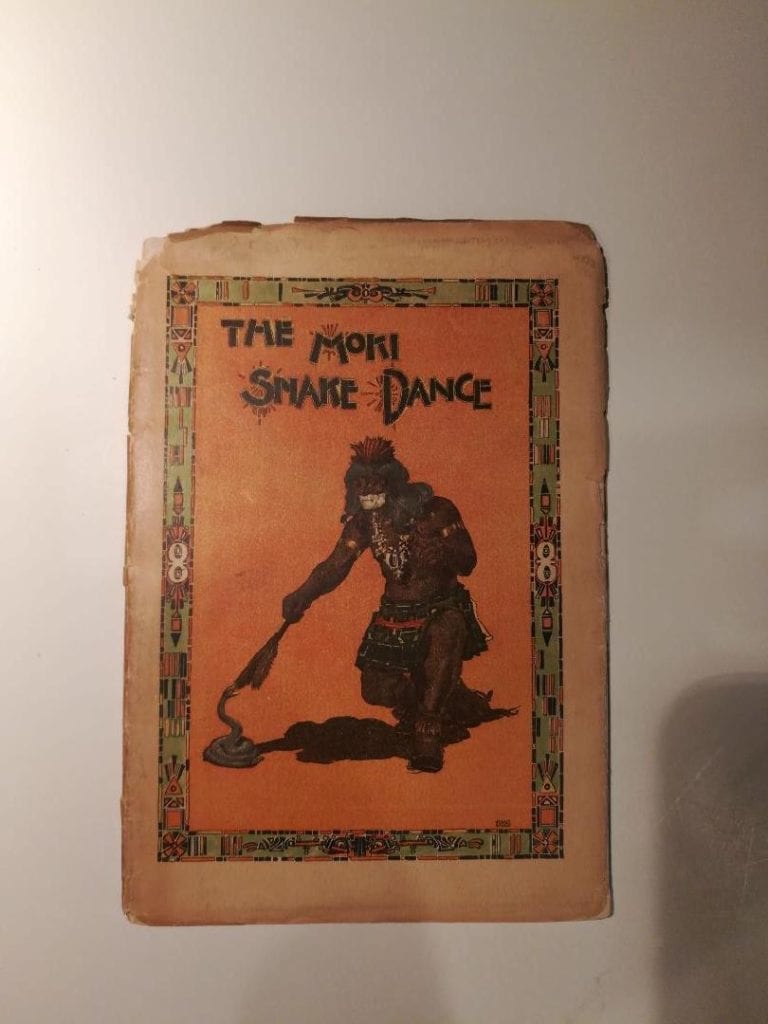
The guide was written by Dr. Walter Hough, an acute observer of Hopi and Hopi-Tea life (see Hough, 1915). Hough was an assistant to Dr. Walter Fewkes who in 1897 and 1900 had published extensive descriptions of the snake dance in the Bureau of American Ethnology Annual Reports # 16 and #19. These reports were reprinted with period photographs by Avanyu Publishing, Inc in 2000 (Alexander, Jr., 2000).
Much of the ritual detail described is confidential to the Hopi and would not be shared today with outsiders. Given a history of inappropriate behavior by Whites in regard to the snake dance, I am loth to publish much information about it here. So that the ceremony is described by a Hopi voice, I will lift a quote from Al Alexander Jr.’s introduction to his 2000 reprint of Fewkes. Al cites a Hopi man, Dan Talayesvia, most famous for his autobiography Sun Chief. The purpose of the snake ceremony, Talayesvia says, is
“the propitiation of the Snake deities and to insure plenty of spring water and abundant rain for the maturing crops. The ceremonies dramatize the legends of the Snake Clan, and the snale priests gather their ‘elder brothers’ ….rattlers, bull snakes and others…wash them ritually, and carry them in their teeth during the public dance. They are then released with prayers, to convey to the Rain Deity. Only the pure in mind and heart can dance successfully with the very wise and sacred snake in his teeth (Alexander, 2000:1).”
Readers wanting more detailed descriptions of the snake dance can refer to the sources cited above.
Above the top framing line on pot 2020-04:
This space is also reptilian, with a few Koyemsi mudhead clowns thrown into the mix.
Partial snakes along the lower edge:
Set along the upper framing line are three clusters of geometric elements. Each cluster rises to form a cairn-like mound. At the center of each cairn is a lair out of which emerges the head of a snake. I speculate that these may represent life emerging from the Third World into this world through the sipipu or snakes emerging from the underworld realm of Massaw, Master of both life and death. Such themes are very much a part of the semi-annual Snake Dance depicted on the jar. The three cairns feature snakes of different colors: black, orange and white.
The black snake is housed in a pattern of geometric elements that occupies 10 of the 21.5-inch length of the framing line. At Hopi, black represents the direction “above” (Wade and Cooke, 2012:28).The pattern of elements is much like that found on the wedge-shaped design below these framing lines and already discussed. A solid crown of triangular points forms the end element. Moving toward the center we find a two-lane “highway” with one white and one orange lane. Following are two identical segments separated by a one-lane orange highway and terminating in a three-lane highway, the center lane orange and the flanking lanes white. The two segments bounded by these highways contain two orange isosceles triangles rising from their lower edge, duplicating the design in wedge design discussed earlier. The residual space is the same crown shape as the end element, but here is white. Following this section is a three-step orange incline, its triangular shapes reflecting both the orange triangles of the earlier segments and the notched orange inclines of the lower sections of design. The smooth underbelly of this incline is a three-lane highway, with the center lane orange and the flanking lanes white. The next space is residual between the linear edge of the highway and the curved form of the snake. This segment is monochromatic: the top half contains a black crow-foot design, the a one-lane highway. The bottom half contains a white-dotted black hill that is bifurcated by a narrow two-lane highway.
The black snake is outlined by a narrow white strip edged with a thin black line. Two body segments are shown, surmounted by the head. Segments are separated from each other and the head by a thin white element. Each segment contains the same unpainted white tulip-shaped form surrounded by black. The head is marked with a white eye and an open mouth; extending from the mouth is an orange arrow with two sharp bends in its shaft. Karl Taube notes that a similar image of a serpent with an arrow emerging from its mouth is found on a Tesuque medicine bowl, which he illustrates (in Hays-Gilpin and Schaafsma, 2010:103, fig 5.21 a), but he does not suggest a meaning for the iconography. Creatures with forms emerging from their mouths is an ancient southwestern motif (cf 1997-05).
To the right of the black snake is another rendition of the yellow “crown” with residual white triangles, followed by a three-lane highway with a yellow lane flanked by white lanes. A wedge-shaped section with a narrow blunt tip follows. At its center is a white-speckled black area, surrounded by a white border. At this point the design narrows dramatically and terminates with another three-lane highway, this time with a center white lane flanked by orange lanes. Following is a long narrow unpainted (white) rectangle, an orange/white two-lane highway and a final smaller orange rectangle.
The design enclosing the orange snake follows but extends only 4-inches along the framing line. [Orange is not a directional color at Hopi, though “red” signified the southeast (Wade and Cooke, 2012:28).] The design is composed of now-familiar elements. First is a white three-stepped form with a think stripe of orange along its edge. Suspended in the white area is a version of a design last seen on the lowest band of design of the jar: a “triangular stealth bomber with a tail or a flower,” here painted black with speckled white dots. The orange snake follows, showing only one body segment with a black trident symbol at its center. The head has the same format as that of the black snake except that here the eye is a simple black circle and the arrow emerging from the mouth is orange. The design to the right of the snake is composed the the same first two elements found to the right of the black snake, except that here the wedge-shaped section is pointed and not truncated.
The design around the white snake extends for 5-inches and is much like that found surrounding the black snake. At Hopi, white represents the direction “northeast” (Wade and Cooke, 2012:28). The design enclosing the white snake begins with:
a three-step orange incline, its triangular shapes reflecting both the orange triangles of the earlier segments and the notched orange inclines of the lower sections of design. The smooth underbelly of this incline is a (two-lane white and orange) highway…The next space is residual between the linear edge of the highway and the curved form of the snake. This segment is monochromatic…
This space contains another image of a “triangular stealth bomber with a tail or a flower, painted black with speckled white dots” that we saw near the orange snake and in the lowest band of design.
The body of the white snake contains the same design elements as the orange snake, the only difference being that the black and orange snakes look left while this white snake looks slightly to the right.
The remaining design, to the right of the white snake, is almost identical to the design in the same position following the black snake, though somewhat truncated:
To the right of the… snake is another rendition of the yellow “crown” with residual white triangles, followed by a three-lane highway with a yellow lane flanked by white lanes. A wedge-shaped section with a narrow blunt tip follows. At its center is a white-speckled black area, surrounded by a white border. At this point the design narrows dramatically and terminates with another three-lane highway, (all three lanes white). Following is a long narrow unpainted (white rectangle, a white/ orange/white three-lane) highway and a final smaller orange rectangle.
The water serpent Paaloloqangw at Hopi:
Anthropologist Polly Schaafsma writes that:
” Quetzalcoatl of Mexico and the horned and feathered serpent of the American Southwest are ancient and complex supernatural beings who share a kaleidoscope of meanings through time and space…
Today the horned serpent continues to be revered as an important deity among the Pueblos and is known by various names among the different linguistic groups, including Kolowisi (Zuni), Paaloloqangw (Hopi), and Awanyu (Tewa). … (T)he serpent may be associated with the four (or six) directions, the colors of which the snakes also assume. Nevertheless, the Pueblo horned serpent is primarily a water serpent, an ambiguous entity both feared and respected. … His home is in springs, ponds, rivers, and ultimately the oceans, all believed to be connected under the earth’s surface, and … may cause torrential rains and floods…
Like Quetzalcoatl, the Southwestern serpent is multifaceted and ambiguous, cosmic in scope, its roles in myth and ritual involving the unpredictable — endings and beginnings, change, transition, and transformation. Both the horned serpent of the Southwest and Quetzalcoatl maintain complex mythological roles in regard to emergence themes, maize and fertility….(They) use their creative powers to assist in the process of human emergence (into this Fourth World) and in bringing material for human sustenance into the current world (Fields and Zamudio-Taylor, 2001:144-145).”
Rain is the central concern of Native people in the southwest: no rain, no crops, starvation. Hence
” the great plumed or horned water serpent is a central component of the Puebloan water and rain complex…Among the Hopi, Paaloloqangw serpents…live in bodies of water, and the create violent storms… (Schaafsma in Fields and Zamudio-Taylor, 2001:116-117).”
Ekkehart Malotki writes:
Overall, the diety represents one of the most powerful embodiments of fertility in Hopi religious imagery. The vegetal fertility association of wells, the abode of the god, is obvious….(T)here is (also) the phallic icon of the snake itself as a potent emblem of genital energy the fertilizes fields in the form of rain and thus produces life-sustaining crops…In addition to being the nurturing god of all the springs and pools actoss the land, the HopPaaloloqangwt also has a dark side. He is believed to be the bringer of floods as well as the producer of earthquakes and landslides (2002:2-6).”
Thus from prehistoric to modern times, the large serpent emerging from the mouth of the jar 2020-04 has had a central place in Pueblo religions and is celebrated in the kivas.
Alexander Steven lived with the Hopi during the last decade of the 19th Century and wrote detailed reports of Hopi life and ritual. His Hopi Journal was published by Elsie Clews Parsons in 1936. His entries for February 1893 provide a detailed look at a kiva dance on First Mesa honoring the Hopi Water Serpent, whose name he spells Pa’lulukonti. Central to the dance is a puppet of Pa’lulukonti:
“The image is 44 inches long, composed of ten hoops tapering from 12 inches in diameter at the base to 4 inches; the one next to the serpant head (which is a gourd) is six inches long; elliptic and 4–1/2 inches in diameter. Cotton cloth is drawn over the hoops which is secured to the cloth, with the cloth cut in a tapering fashion to fit snugly around the hoops. Cloth is painted black above, red and green longitudinal stripes and white underneath. Notched teeth are ut in the tip of the gourd stem about half way between the eyes and a little back from them, A loop is fastened at the large hoop at the base, which loop is passed over the head of the man who operates — the serpent is thus supported from the back of his neck — his right arm thrust in the tubular body (Parsons, 1936 293-294).”
Steven offers a drawing of the puppet:
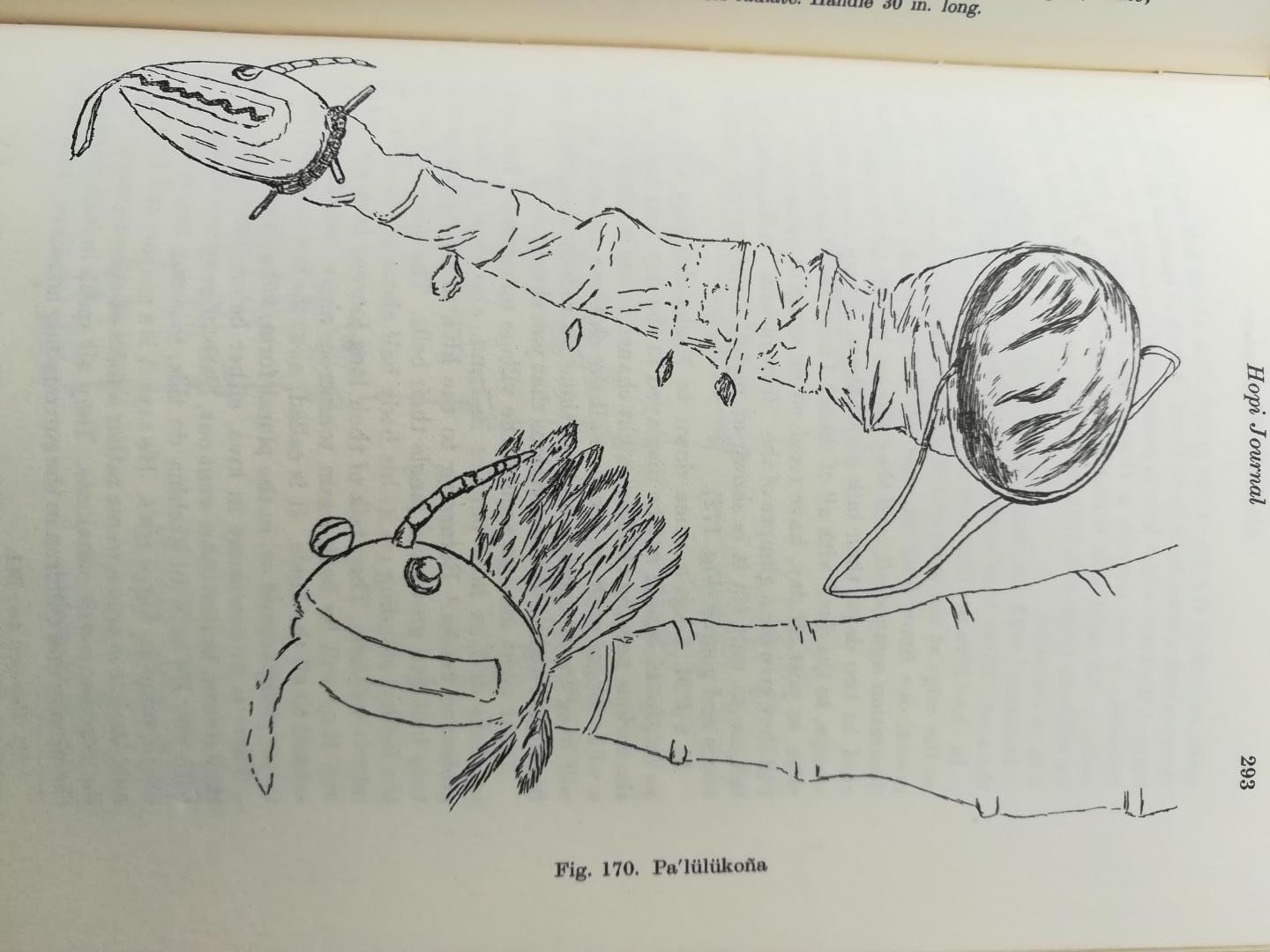 (Parsons, 1936:293)
(Parsons, 1936:293)
When the Pa’lulukonti dance is performed, the audience and puppeteers are separated by a cloth screen. Jesse W. Fewkes described the event in 1900 at Walpi, on top of First Mesa:
” A hoarse roar made by a concealed actor blowing through an empty gourd resounded from behind the screen, and immediately (six) circular disks (in the cloth screen) swung open upward, and were seen to be flaps flaps hinged above, covering orifices through which simultaneously protruded six artificial heads of serpents, realistically painted. Each head had protuberant goggle-eyes and bore a carved horn and a fan-like crest of hawk feathers. A mouth with teeth was cut in one end, and from this orifice there hung a strip of leather painted red, representing the tongue.
Slowly at first, but afterward more rapidly, these effigies were thrust farther onto view, each revealing a body 4 or 5 feet long, painted like the head, black on the back and white on the belly. When they were fully extended, the song grew louder, and the effigies moved back and forth raising and depressing their heads in time, wagging them to one side or the other in unison (1903:41).”
The puppets then knock over model corn plants, perhaps representing the sowing and fecundity of Hopi fields. Steven, writing in February 1893 of the ceremony at First Mesa explains what happens next:
“Hahai’wuqti (Grandmother of the kachinas) cast meal upon (the puppets). They are all her children. She feeds them with the meal as a mother suckles child….The movements of these serpents are not at all stiff and jerky, not at all mechanical, but extremely lifelike and vivid (Parsons, 1936:306).”
Mischa Titiev describes a Water Serpent dance he witnessed at Oraibi in the early 1930’s. He concludes that this dance:
“carries a deeper significance and embodies a more elaborate set of rites than any other Katcnina performances except the Powamu and Niman (1944/1992:121).”
Oscar Branson provides an image of a modern Water Serpent puppet, which he notes is accompanied by mudhead dancers, as shown on Sumatzkuku’s pot:
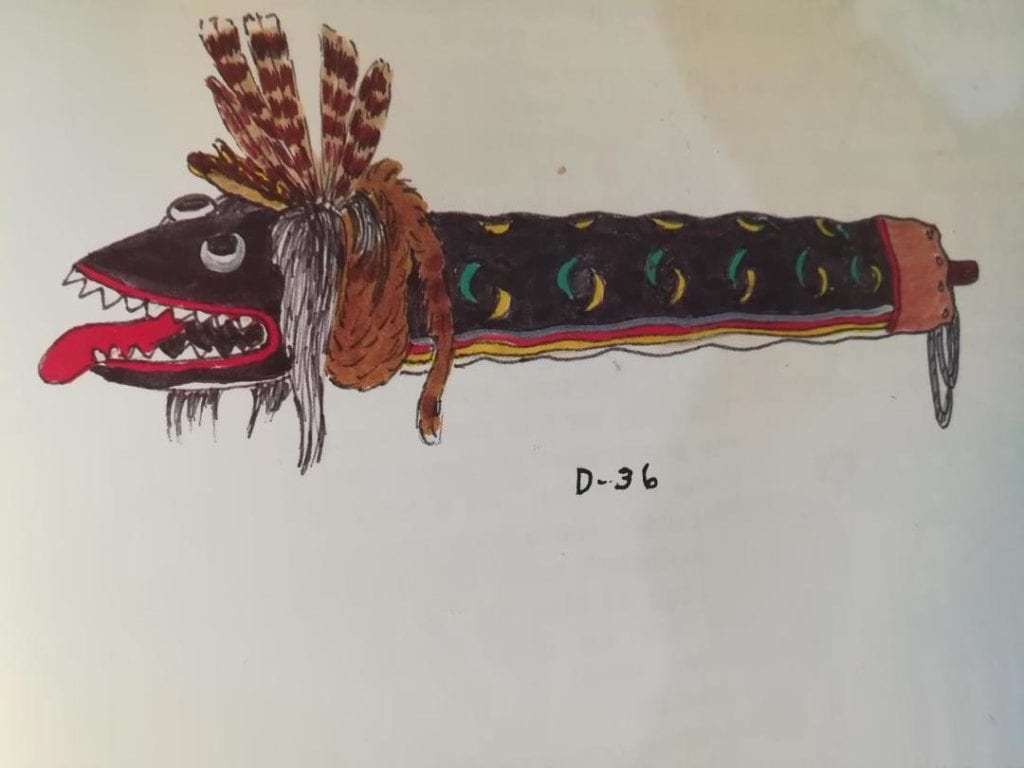
(Branson, 1992:199)
This image and reference to mudheads is so similar to the image on pot 2020-04 that I wonder if Branson’s depiction was a direct inspiration for Sumatzkuku.
The large blue Paaloloqangw serpent emerging from the mouth of jar 2020-04:
Because of its ritual meaning, the drama of its presentation in the kiva, its striking form and color and its placement on the upper surface of the pot, the Paaloloqangw snake surrounding the jar’s opening is the most compelling image on jar 2020-04.
The face of the serpent is gourd-shaped, with a broad upper face and a somewhat narrower mouth and chin, all an inky black. A fan of nine hawk feathers with black barbs at the top and white barbs at the base frame the head. White shafts divided each feather. At the top of the forhead is a blue trident shape, perhaps the track of an animal. On either side of the face are irregularly-jumbled strands of blue yarn. The eyes, white circles with black pupils, stare at the viewer. The mouth has bright red lips and displays two rows of fierce triangular teeth. A long, thin red tongue protrudes. All of these facial features are also evident on Branson’s depiction of the serpent puppet, above. Two patois prayer feathers dangle on either side of this face.
Twenty body segments undulate behind the head, curling around almost the full circumference of the pot before the tail disappears into the small mouth of the jar.
“Ceremonial Paaloloqangw performances are staged in a variety of forms. The…(Water vessel snake) features single serpent marionettes rising from water jars (Malotki, 2002:11).”
Each segment of the snake on jar 2020-04 is black with a blue framing line above white scales marking the creature’s underbelly. Embedded in each is a large blue “U” element, perhaps representing scales. Each segment is separated from its neighbor by a three-lane “highway” with a central black lane flanked by blue lanes. Blue is associated with the direction southwest (Wade and Cooke, 2012:28).
Koyemsi clowns:
Riding the snake are four Koyemsi or “mudhead clowns,” though Barton Wright notes that both names are erroneous, the proper name at Hopi being Tachuki or Tatsi’oktu.’, meaning “Ball-on-Head.” Nevertheless, the inaccurate names persist and are misleading, Wright explains since
“…(T)he Koyemsi serves a multiplicity of purposes. Even though he is amusing and can perform hilarious antics or play ingenious games–both with the audience and other Koyemsi– he is far more than a clown. He can be curer, magician, dance director, a warrior, a messanger, a sage, or a fool…(T)heir actions and even their very names are inverted…They are the opposite nature to that indicated by their names and they speak the reverse of what they mean, as do all from the Underworld. Despite such simple behavior, the Koyemshi are very dangerous and it is the height of foolishness to deny them anything…In the Koyemsis’ most common role as interlocutors between kachinas and humans, they announce impending events, translate requests, give directions, and present other information, albeit in a garbled or inverted fashion such as telling the men to do women’s work and vice versa (1994:67-71).”
As their name implies, mudhead clowns display reddish-tan skin, the color of the fine sand dust at Hopi. On jar 2020-04 three Koyemsi lie prone on the snake and seem to be holding on “for dear life” as the snake undulates beneath them. The lead koyemsi, in contrast, rides confidently sitting up just behind the snake’s head, his left hand holding a white strap that guides the snake and his right hand raised in salute, like a bucking bull rider at a rodeo.
The costume of the sitting Koyemsi can be clearly seen. The costumes of the two mudheads immediately behind him are more obscure since they can only be seen in profile; the final koyemsi is almost flat against the underside of the snake and thus is only fractionally visible. There is a great variety of koyemsi (Wright, 1994: 96-97) and I am unable to specify which is depicted on jar 2020-04. The image may well be generic rather than particular.
A conical horn emerges from top of the head o the lead mudhead, its tip displaying blue feathers. Eyes and mouth are doughnut-shaped; the nose more-subtly indicated. Characteristic round tan balls replace his ears. A blue bandana encircles his neck. Around his left wrist is tied a leather band. He wears brief blue britches. His tan moccasins have white soles.
The middle two koyemsi are similarly dressed, although the bandana around their necks is somewhat darker that that found on the lead clown. Two prayer feather patois, each composed of two tiny blue feathers with white tips “hang” upwards from their prone heads. From the little that can be seen, the final koyemsi is similar except that his bandana might be red rather than blue.
The image of the koyemsi clowns riding the fearsome water snake on jar 2020-04 is both funny and frightening, perhaps an appropriate response to a Water Snake dance organized by koyemsi in a dim kiva.
Overall assessment of jar 2020-04:
Writing (and reading) this detailed description of the design on pot 2020-04 is exhaustive. Throughout the jar, but particularly on the lower segment, a limited number of geometric elements in a variety of colors are repetitively configured and reconfigured into angular patterns more characteristic of Navajo weaving than typical Hopi design. In contrast, much of the middle band of design is defined by human forms, two lines of Hopi men dancing the snake ceremony. Finally, on the upper surface of the jar, the fearsome Paaloloqangw water snake, koyemsi mudheads and emergent snakes add both drama and humor to the design. That’s a lot of visual variation, even on a large pot, but the detail and precision with which Peter Sumatzkuku arranges the elements results in an engaging, rather than a frenetic, impression.
I still don’t understand how such precise detail of painting is possible if drawn freehand, but I’m not an artist and the result is both unique and spectacular. For about 20 years Les Namingha has been using acrylic paints on bisque-fired pots, but his designs are abstract and nothing like the designs seen on jar 2020-04. Using broader strokes than Sumatzkuku, Lawrence Naomi also paints allegorical figures on his pottery (2015-05). I am not aware of any other Hopi artist who has created pottery with such realistic and geometric design. The ceremonies shown on jar 2020-04 are perhaps the most dramatic of the many organized by the Hopi to honor the Gods. Their representation on this jar is both a blessing and beautiful presence in my home.

